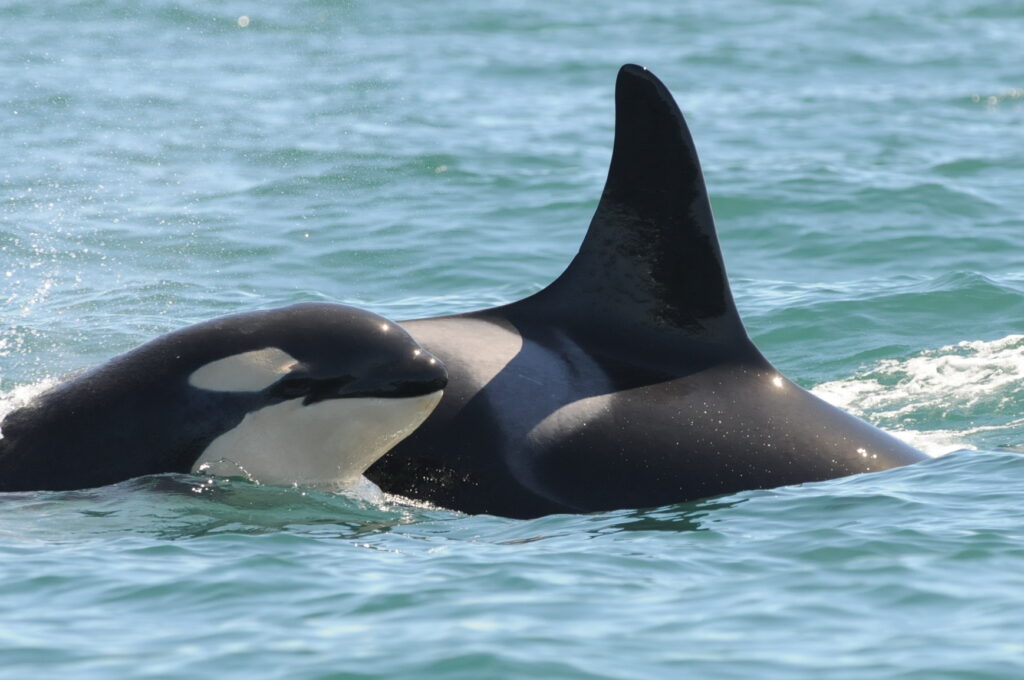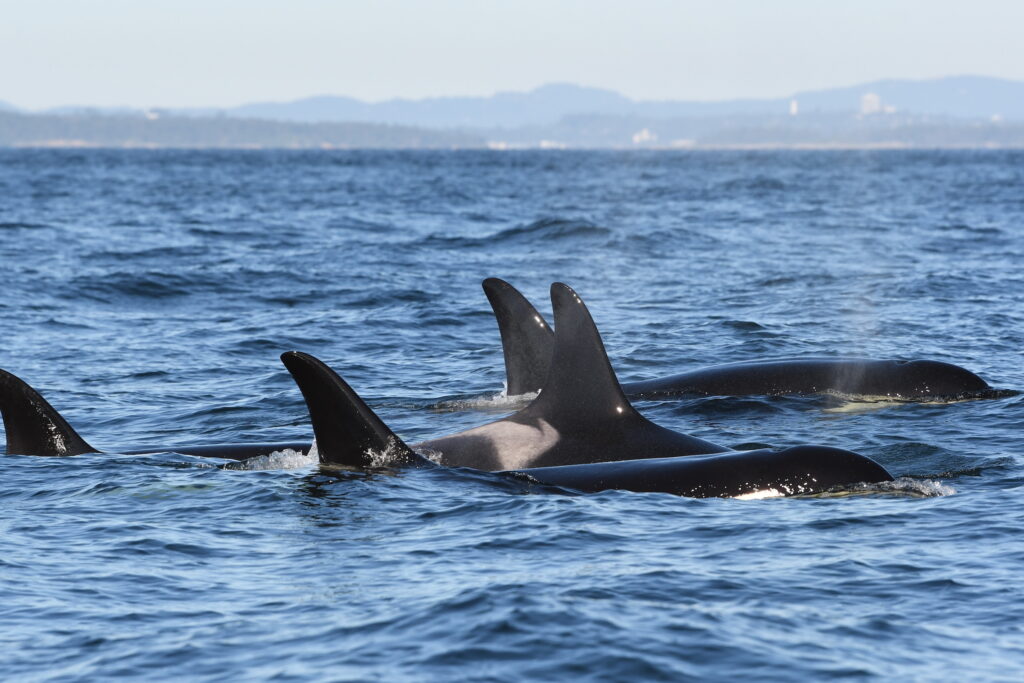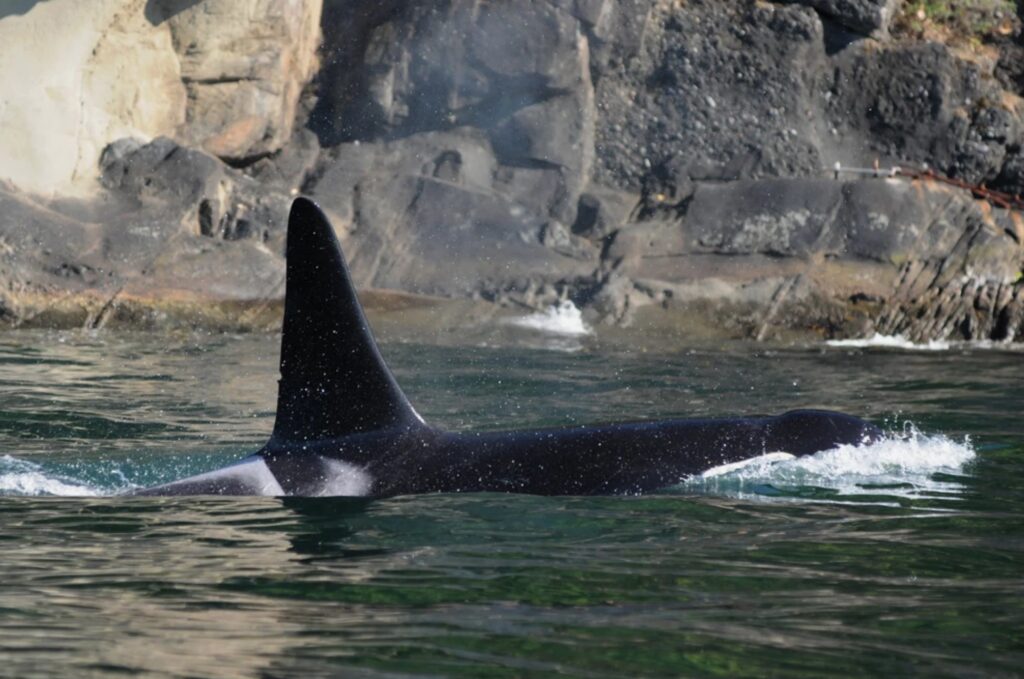The annual census of the endangered Southern Resident killer whales, submitted yesterday to the federal government, shows three births and one death from mid-2020 to mid-2021.
Along with the new census report, Ken Balcomb of the Center for Whale Research sadly confirmed the death of L47, a 47-year-old female named Marina, who has been apparently missing since early summer.

Photo: Center for Whale Research
Marina was last seen by CWR biologists on Feb. 27 in Swanson Channel, north of the San Juan Islands, Ken told me. She was later missing from observations by Canadian biologists who encountered her family members in the western Strait of Juan de Fuca.
As in recent years — as opposed to historically — the L pod whales have not been spending much time in Puget Sound during the summer. It was not until this month that Ken’s staff was able to get a good look at the whales during six separate encounters that identified Marina’s three offspring along with their two offspring — but no Marina. Check out Encounter 74.
The official census of Southern Residents reports the population as of July 1 each year, although Ken and his associates must complete their report under a federal contract by Oct. 1. That gives them time to draw on all observations up until then. This year’s census will show 74 whales — two more than last year, thanks to three births along with the one death. But the actual number of Southern Residents today stands at 73, because another orca — 35-year-old K21 (named Cappuccino) — is believed to have died in late July or early August — after the census cutoff date.
The newest whales added to the population are J57, a male named Phoenix born last September to Tahlequah ( J35); J58, a female named Crescent born last September to Eclipse (J41); and L125, a calf (gender unknown) born in February of this year to Surprise! (L86). The two one-year-old calves were discussed in last year’s blog post about the census (Our Water Ways, Sept. 15, Oct. 6, 2020.)
The number of whales in L pod now totals 33, J pod has 24, and K pod has 16. This does not include Lolita/Tokitae, an orca from L pod that was captured in Puget Sound and is held at the Miami Seaquarium in Florida.
L47, Marina
Marina (L47), who showed no health problems before her death, had given birth to seven calves that survived long enough to be designated with “L” for their pod and the next number in sequence. That’s more orca babies than any other Southern Resident in the record books, although four of Marina’s offspring died at a young age, according to CWR.

“L47 experienced more than her fair share of loss, with four calves not surviving past their first year,” according to a commentary on the CWR website. “Her three surviving offspring are L115, a young male, and L83 and L91, two adult daughters. L83 and L91 are raising sons of their own, L110 and L122.
“As a mother and grandmother,” the statement continues, “L47’s death may have severe consequences. Center for Whale Research data shows that older, post-reproductive females hold key leadership roles in this society, particularly when food is scarce. L47’s matriline members now face an increased risk of death in the coming years. Her son, L115, is at an approximately three times greater risk of death in the next two years than a male of the same age would be with a surviving mother.”
Marina’s son, L115 named Mystic, is only 11 years old. His sisters are 31-year-old L83, named Moonlight, and 26-year-old L91, named Muncher. Moonlight’s 14-year-old son is L110 named Midnight, and Muncher’s 6-year-old son is L122 named Magic.
Marina and her two daughters, Moonlight and Muncher, are fondly remembered among the so-called Dyes Inlet whales, a group of 19 orcas that spent a month between Bremerton and Silverdale in 1997. Their presence helped to educate and fascinate thousands of people around Puget Sound about the ways of the whales. (See the anniversary story package in the Kitsap Sun, November 2007.)
By my count, the loss of Marina leaves only five whales, all females, from the 19 that visited Dyes Inlet 24 years ago. Other than Marina’s two daughters, there was L90 named Ballena, who was 4 years old at the time; L55 named Nugget, who was 20; and Nugget’s daughter, L82 named Kasatka, who was 7. Nugget has four offspring alive today, and she became a grandmother for the first time in 2010 when Kasatka had a male calf, L116 named Finn. (The original 19 Dyes Inlet whales.)
K21, Cappuccino
Cappuccino’s death came after the census cutoff date, but that makes no difference to the outpouring of sympathy for a whale that was last seen on July 28 in distress, emaciated and in his final days, as confirmed in videos provided to the Center for Whale Research.

The male orca with a broad dorsal fin was well-known and easily identified, even from a great distance, according to whale observers. When last seen, his dorsal fin had collapsed, a clear sign of a grave health condition.
At 35 years old, Cappuccino was the oldest male among the southern residents. Another iconic male, 43-year-old Mega, or L41, was last seen in August 2019 and was hailed as the father of 20 known offspring (Our Water Ways, Jan. 30, 2020). Genetic studies have not found any offspring from Cappuccino.
“While K21’s condition is heartbreaking, we celebrate his life as a story of flourishing under adversity,” says a statement from the Center for Whale Research. “Males born in the Southern Resident population have an estimated average lifespan between 20 and 30 years, and few Southern Resident males reach K21’s age of 35.
“In the years after his mother died (2004), K21 was at even greater risk, but he endured and maintained a close social relationship with his sister and, later, his adopted family, the K16s,” the statement continues. “K21 is one of the most well-known and iconic members of the Southern Resident community. His broad dorsal fin and bright, open saddle patch make him distinct even from great distances. We grieve for his pain and the loss his death would represent for the Southern Residents.”
As Seattle Times reporter Lynda Mapes put it when the news was first reported: “The grief felt by many right now is not only for a beloved whale, but for the passing of a way of life in the San Juan Islands, where the Southern Residents hardly visit any more. And when they do, they are too often struck by tragedy, carrying their dead calf or breathing their last breaths.”
Lynda’s story quoted my old friend Kelley Balcomb-Bartok, who grew up around the whales and assisted his father with the research.
“It’s a lost era, a lost place, those long summer days even before the sun rose you could hear the blows of them resting and relaxing; their tummies are full, they are just enjoying life,” Kelley was quoted as saying. “There was a joyfulness to the time and the place and the animals. That is what everyone pines to return to.”
Cappuccino was the oldest male, but now Southern Resident orcas — especially males — don’t survive as long. Based on the charts, three 30-year-olds are now the oldest males. They are Mike, J26; Blackberry, J27; and Mystery, L85. For details, visit The Whale Museum’s “Meet the Whales” and Orca Network’s “Births and deaths since 1998.”
Orca pregnancies
The organization SR3 (Sealife Response + Rehab + Research) recently reported that three female orcas in J pod appear to be pregnant, based on body measurements conducted from a remotely controlled octocopter (drone). The Washington Department of Fish and Wildlife responded to the report by issuing an emergency order (PDF 182 kb) to keep commercial whale-watch boats back at least one-half nautical mile (0.58 mile) from the three whales.
Declaring the whales “vulnerable” under state rules, department officials also are asking recreational boaters to give the whales extra space and be careful to abide by the Be Whale Wise regulations, which include keeping boats back from the whales at least 300 yards to the sides and 400 yards in front and behind.
The three whales that appear to be pregnant are J36, a 22-year-old named Alki; J37, a 20-year-old named Hy’Shqa; and J19, a 42-year-old named Shachi.
“We’ve got many people looking at the science to understand where we can continue to improve the odds for this population,” Kelly Susewind, WDFW director said in a news release. “Now that we’ve learned of multiple pregnancies among the Southern Residents and the impact that boats can have on new mothers, we really need everyone to follow Be Whale Wise regulations in support of these endangered whales’ survival.”
Studies have shown that food is critical to killer whales in their final month of pregnancy and that vessels approaching the whales can disrupt their feeding behavior, especially for females, according to the news release. Southern Resident orcas, like their cousins the Northern Residents, eat salmon, primarily Chinook salmon. Transient or Biggs killer whales consume marine mammals, including seals and sea lions, and the transients are being seen more frequently within Puget Sound.
While the SR3 researchers hope for successful pregnancies among the three orcas they have observed, the number of failed pregnancies remains high among Southern Residents.
“Last year, we documented a number of other pregnant females, who were not successful in rearing calves,” said researcher John Durban, who worked with the SR3 team to gather aerial photos. “Unfortunately, this is not unusual, and we have documented a high rate of reproductive failure over the last decade. The survival of every calf is crucial to the endurance of this small and endangered population. Every calf matters.”
See also SR3’s blog post on the subject of adaptive conservation measures in response to the drone findings.

No Comments yet!